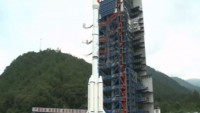China Silent on Destruction of Gaofen-10 Satellite Launched Aug. 31
| Arthur Dominic Villasanta | | Sep 02, 2016 05:18 AM EDT |
(Photo : Public Security Department of Shaanxi Province) Debris, probably from the Long March rocket carrying Gaofen-10, litters the ground in Shaanxi.
China refuses to officially admit the loss of the Gaofen-10 dual-use civilian and spy satellite that smashed to pieces onto the soil of Shaanxi Province after the Long March 4C carrier rocket taking it into orbit blew-up in flight.
The loss of Gaofen-10, officially called an Earth observation satellite, was China's first orbital launch failure this year and the first failure since 2013. The satellite was launched from the Taiyuan Satellite Launch Center on Aug. 31. The word Gaofen means "High Resolution."
Like Us on Facebook
Chinese media reports claim the problem occurred in the rocket's third and final stage. The mechanical glitch reduced the booster's speed, causing it to plunge towards the Earth. Most of the booster and the satellite burned up as they re-entered the atmosphere,.
China's official news media has so far kept silent about the failure. State-run CCTV, however, broadcast the rocket's launch but didn't issue any follow-up reports, which China watchers say is an indirect confirmation the mission was a failure.
The loss of the satellite was revealed to the world by aihangtian.com, a website run by Chinese professional astronautic experts and space enthusiasts. Confirmation of the loss of Gaofen-10 was made by the police department in Shaanxi Province.
The Public Security Department of Shaanxi Province published on its Weibo social media account a series of photos showing large pieces of what appears to be the Long March 4C booster. Police took the photos as part of a mission searching for the remains of Gaofen-10. They later removed all the photos and the stories about the search mission from Weibo.
Officially, the destroyed Gaofen-10 carried China's newest generation optical sensors developed indigenously. It was to have operated in a Sun-synchronous orbit and would have crossed the equator 12 times a day.
Gaofen-class satellites are forming a constellation that will give China a global network of earth observation satellites with high-definition, all-weather, 24-hour intelligence gathering capabilities for military and civilian users by 2020. The network is designed to be able to monitor any spot on earth.
Gaofen is a series of civilian Earth observation satellites developed and launched for a state-sponsored program called "China High-definition Earth Observation System" or CHEOS.
CHEOS is a near-real time, all-weather, global surveillance network consisting of satellite, stratosphere airships and aerial observation platforms.
Space experts in the West, however, have long claimed China's "earth observation satellites" and "remote sensing satellites" are primarily military spy satellites in civilian guise. China's space program is controlled by the People's Liberation Army (PLA).
The last successful launch of a Gaofen-class satellite took place last Aug. 10. A Long March 4C rocket from Taiyuan successfully orbited Gaofen-3 carrying China's most powerful space-based radar. The Synthetic Aperture Radar or SAR can penetrate clouds and even the ground to monitor areas of interest at up to one meter resolution. Gaofen-3's antennas measure 18 meters, longer than any other Chinese satellite.
The orbiting of Gaofen-3 was described as a "small but important step" in China's march to become a space power, said Prof. Wu Shunjun, a radar technology expert at the National Lab of Radar Signal Processing in Xidian University, Xian
TagsGaofen-10, Earth observation satellite, china, Long March 4C, Shaanxi province, Gaofen-class satellites, Gaofen-3
©2015 Chinatopix All rights reserved. Do not reproduce without permission
 China Reveals Orbiter, Lander and Rover for 2020 Mars Mission
China Reveals Orbiter, Lander and Rover for 2020 Mars Mission China Launches its First Mobile Telecommunications Satellite
China Launches its First Mobile Telecommunications Satellite Booster of Chinese Rocket that Orbited ASATs Built to Destroy US Satellites Burns-up over West Coast of USA
Booster of Chinese Rocket that Orbited ASATs Built to Destroy US Satellites Burns-up over West Coast of USA China and Russia Continue Anti-Satellite Missiles Tests to Prepare for Space War
China and Russia Continue Anti-Satellite Missiles Tests to Prepare for Space War
EDITOR'S PICKS
-

Did the Trump administration just announce plans for a trade war with ‘hostile’ China and Russia?
-

US Senate passes Taiwan travel bill slammed by China
-

As Yan Sihong’s family grieves, here are other Chinese students who went missing abroad. Some have never been found
-

Beijing blasts Western critics who ‘smear China’ with the term sharp power
-

China Envoy Seeks to Defuse Tensions With U.S. as a Trade War Brews
-

Singapore's Deputy PM Provides Bitcoin Vote of Confidence Amid China's Blanket Bans
-

China warns investors over risks in overseas virtual currency trading
-

Chinese government most trustworthy: survey
-

Kashima Antlers On Course For Back-To-Back Titles
MOST POPULAR
LATEST NEWS
Zhou Yongkang: China's Former Security Chief Sentenced to Life in Prison

China's former Chief of the Ministry of Public Security, Zhou Yongkang, has been given a life sentence after he was found guilty of abusing his office, bribery and deliberately ... Full Article
TRENDING STORY

China Pork Prices Expected to Stabilize As The Supplies Recover

Elephone P9000 Smartphone is now on Sale on Amazon India

There's a Big Chance Cliffhangers Won't Still Be Resolved When Grey's Anatomy Season 13 Returns

Supreme Court Ruled on Samsung vs Apple Dispute for Patent Infringement

Microsoft Surface Pro 5 Rumors and Release Date: What is the Latest?










